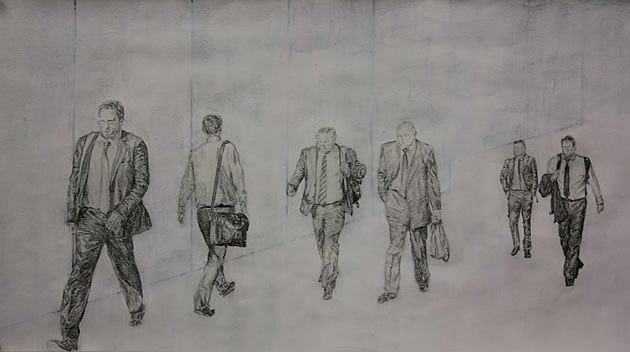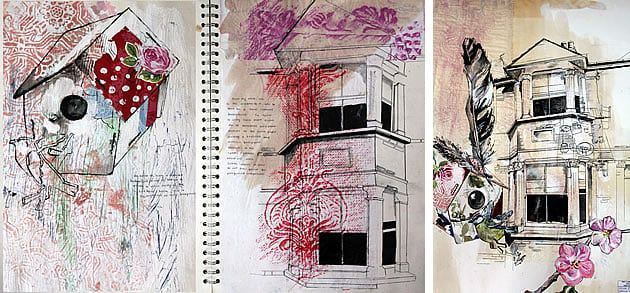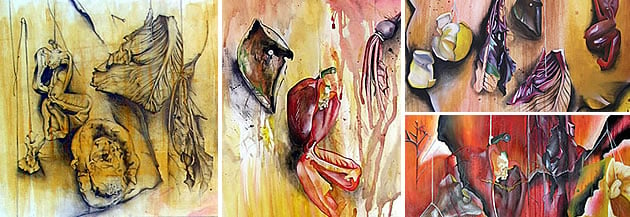Last Updated on April 2, 2023
Are you struggling to get your Art projects done on time? Some students – even those who are dedicated and hard-working – find it challenging to work at the pace required in a Visual Art course. The skilful, perfectionist student usually falls into this category; those who produce meticulous, highly-detailed observational drawings or paintings. Parents and teachers can be unsure how to provide practical, positive strategies for improvement. This article lists fifteen ways that a high school Art student can work faster, without compromising the quality of their work.

1. Use a ground
There are many benefits to working on a ground. One of these is increased painting or drawing speed. A ground covers a painting or drawing surface from the outset. It can act as mid-tone, with only black and white used to apply dark and light areas (as in the examples below) or be left partially visible in the final work. This results in an artwork that is much faster to complete (see our article about painting on grounds for more information).
An A Level Art portrait by Mariam Shafei-Sabett from Dame Alice Owen’s School, Hertfordshire, England and a teaching exemplar from Amiria Robinson:

2. Incorporate mixed media /patterned surfaces / textural elements
As with using a ground, patterned, decorative or textural items can cover areas of an artwork quickly. Although this strategy should be used with care, selecting only materials which support or enhance your project (usually with reference to a relevant artist model) this can be a great way to speed up your project and introduce creative use of mixed media.
Two AP Studio Art (Concentration) pieces by Alyssa Church from Bingham High School, South Jordan, Utah, United States:

Domestic Violence series by artist Scott Waters:

Please read this article for more exciting ideas about how to use mixed media within your work.
3. Work on several pieces at once
Working in series – completing several paintings or drawings at one time – is a very helpful strategy for Art students. This speeds work up for a number of reasons:
- A single colour can be used throughout a number of works, without needing to stop for remixing / washing brushes
- While one work is drying, another one can be worked on
- Similar processes or techniques can be mastered quickly and repeated on subsequent works
In addition, when working on several pieces at once, ‘preciousness’ about the work tends to be lost, leading to more experimentation and greater work speed.
The studio of artist Willem de Kooning:

4. Paint things in the right order – background areas first
Painting things in an illogical order is surprisingly common amongst high school Art students. In almost all cases, the background should be completed first, followed by the middle-ground, ending with the foreground. This is easily understood when considering a tree in front of a cloudy sky. If you make the mistake of painting the tree first, the sky has to be meticulously painted around every leaf and branch: an irritating task that takes hours (and ends up looking a little shabby). Painting the sky first, however, means that a large brush can quickly be used to paint the sky, with the tree then easily added over the top. Painting in the correct order also results in a painting that has layers (which gives it a richness and lustre, as with using a ground). If you find that subsequent layers of paint do not adequately cover earlier ones, you have an inferior brand of paint. (We will detail our paint and art supply recommendations in an upcoming article – stay tuned)!
Note: Once you understand how to build up a painting in layers, you will realise that often this involves drawing items in stages also.
Paintings by artist Susan Danko:

5. Use masking tape to create straight edges
Some students are concerned that it might be necessary to ‘prove’ that a straight line can be painted by hand. This is not the case. Your control of a paint brush can be ascertained immediately by looking at the remainder of your painting. Masking tape creates straight edges in seconds. Once mastered, this trick can save you hours – and make your paintings sharper, cleaner and more professional in the process. If you haven’t used masking tape before, buy some now!
This painting is by Amiria Robinson (me):

6. Leave artwork purposefully incomplete
Artist work is sometimes purposefully ‘unfinished’. Art students shouldn’t feel obliged to ‘complete’ every item. There are many occasions when a fully rendered drawing is not necessary. Drawings, especially those in sketchbooks, can be left with edges trailing away and tone only applied to some areas. Leaving work unfinished is particularly useful when conducting visual research, exploring ideas and experimenting with media. Depending on your artist influences, this may even be appropriate in final works – as a way to draw attention to focal points and direct attention within an artwork.
Note: This should not be used as justification for avoiding homework tasks set by your teacher!
Jim Dine’s tool drawings:

Drawings by Megan (left), Parrish (top right) and Anna (bottom right) from the Art Department of Cedar Ridge High School, Hillsborough, North Carolina, United States:

7. Omit parts of a scene
Deliberately picking out certain parts of a scene to draw has a strong impact on the final work and must be used with care to ensure that the resulting image supports the ideas explored in your project. As with the previous option, this allows you to demonstrate strong observational drawing skills, while saving time by omitting part of the scene.
A graphite pencil drawing by Langdon Graves:

An A Level Art drawing by Madeleine Ferns:

8. Selectively flatten tone
Another option that students have is to flatten tone – to remove the smooth blending gradations from dark to light. This strategy should be used with caution – and usually only in certain areas – as unintentionally flattening tone can be the hallmark of a weak student. As indicated by the artist examples below, however, there are times when all or parts of the tonal variation within an artwork can be omitted with great success.
‘No one wants to play SEGA with Harrison Ford’ by artist Brandon Bird:

Self portraits from Annemarie Busschers’ ‘Beyond Grief’ series:

9. Focus on Line
There are many occasions where it may be appropriate for a high school student to draw using only line (it is often the application of tone that is time-consuming for students, so working exclusively with line can provide a welcome relief). Blind drawings, contour drawings, cross contour drawings and other hatched drawings (please see our collection of beautiful line drawings for ideas) can form an important part of your project.
Note: It is usually necessary to demonstrate an ability to apply tone at some point to examiner, so it is not wise to exclude tone from your project altogether.
A Level Art sketchbook pages by Annie Jones:

Contemporary drawings by artist Federico Infante:

10. Include your own photographs
While there is a certain quantity of painting and drawing that must take place within a Painting or Fine Art portfolio, photography can provide an excellent mechanism for moving a project forward at a faster pace.
An AS Art sketchbook page by Littlemissnoface:

In addition to helping with composition planning, original photography can be collaged into artworks or used as background. (This should not be used as a mechanism for avoiding observational drawing – this is perceived by examiners as cheating. For example, do not paint a realistic portrait directly onto a photograph of that person). If the photograph remains visible in the final work, less paint needs to be applied, thus speeding up the art-making process.
Painting on photographs by artist Charlotte Caron:

11. Develop towards abstract (or semi-abstract) pieces
Producing abstract work is often the first solution that comes to mind for those who work slowly; students can be fearful that this will not allow them the opportunity to demonstrate strong observational skills. The solution is to produce abstract work that is derived from earlier realistic works, as in the A* A Level example below by Hania Cho:

Another equally successful strategy is to incorporate realistic elements with abstract works, creating a work that is part realistic, part abstract.
Part of an AS Art examination by Nikau Hindin:

12. Use a bigger brush
There is something surprisingly liberating about painting with a bigger brush – especially if you have previously worked at a microscopic scale, picking out detail the size of a pin prick. You will soon discover that it is just as easy to achieve clean edges with a larger brush and that an unexpected level of detail can be achieved. Most enjoy picking up a larger brush – even if this just becomes a way for creating grounds and applying background layers.
Daily paintings by artist Cathleen Rehfeld:

13. Be more gestural
Instead of artwork being a laborious process that grinds away for days, images can be created quickly, using rich, expressive mark-making. Those who have only produced realist, tightly controlled drawings usually take some time to adapt to this approach and not all students find it easy; selection of the right drawing tools and mediums can help. Charcoal, chunky 5mm wide graphite leads, Indian ink, big brushes and paint applied with pieces of card all lend themselves to gestural mark-making (please read Beyond the Brush: Inventive Mixed Media Techniques if you are looking for more ideas). Even if this style of working is not your preference and not something you wish to pursue, it can be useful to practise, particularly when planning compositions and drawing from life.
Paintings by artist Jason Shawn Alexander:

Compositional sketches and a final painting by artist Edward Hopper:

14. Trace or photocopy your own drawings
Tracing is frowned upon in almost all circumstances (see our article about observational drawing for more on this), however there are occasions when tracing your own drawings is a valuable strategy in a high school Art project. For example, a compositional plan could be quickly enlarged on a photocopier and traced/modified as required, instead of being redrawn at a larger scale; or your own drawing could be traced or photocopied in order to trial application of a different medium or technique (this should be kept to a minimum, however, to ensure that your work doesn’t become too repetitive); repeat patterns could be traced; or different drawings could be overlaid and arranged together, tracing the composite work.
A Level Art Coursework by Nikau Hindin:

NOTE: Students should NOT, in any circumstances, trace from photographs (even when the photographs are their own). Almost all high school art programmes assess a student’s ability to replicate shape, proportion and form. Tracing photographs offers an unfair advantage (and is hence a form of cheating), disadvantaging students who take the time to produce accurate observational drawings by hand. Although adult artists sometimes do sometimes trace from photographs, these adult artists are not being assessed on the accuracy of their observational drawings as part of a qualification in which they are competing against others.
15. Use digital manipulation
Scanning existing artworks and editing and combining these with other artworks holds exciting promise for Painting / Fine Art students. Once a student has practised using image manipulation software (such as Adobe Photoshop) creating new digital images and then printing them can be a very fast way to create amazing artworks. Students should be careful not to overuse this strategy, however, and must ensure that all digitally manipulated material is their own original work.
Digitally manipulated images from Nikau Hindin’s A Level Art Coursework Project:

Did these tips help?
If you found this article helpful or know others who would benefit from reading this, please share it using the social media buttons below!
Note: If your problem is not speed but procrastination, you may also benefit from reading How to Stop Procrastinating and Get Your Art Homework Done.

